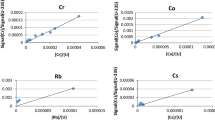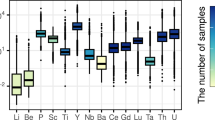Abstract
This work describes a method for the discrimination of uranium ore concentrates (UOCs) to support provenance assessment for nuclear forensics applications using samples representing twenty producers from around the world. The concentrations were measured using inductively coupled plasma mass spectrometry. UOCs were classified using the support vector machine method relying on 61 down to only 18 element concentrations without affecting the accuracy. New features are calculated from combination of elements from the selected 18 elements, and added to the selected elements improve the classification results. Reducing the number leads to the optimization of laboratory measurements of element signatures in support of nuclear safeguards and forensics applications.



Similar content being viewed by others
References
Mayer K, Wallenius M, Varga Z (2013) Nuclear forensic science: correlating measurable material parameters to the history of nuclear material. Chem Rev 113(2):884–900. https://doi.org/10.1021/cr300273f
Keegan E, Wallenius M, Mayer K, Varga Z, Rasmussen G (2012) Attribution of uranium ore concentrates using elemental and anionic data. Appl Geochem 27(8):1600–1609
Varga Z, Wallenius M, Mayer K, Keegan E, Millet S (2009) Application of lead and strontium isotope ratio measurements for the origin assessment of uranium ore concentrates. Anal Chem 81(20):8327–8334. https://doi.org/10.1021/ac901100e
Keegan E, Richter S, Kelly I, Wong H, Gadd P, Kuehn H, Alonso-Munoz A (2008) The provenance of Australian uranium ore concentrates by elemental and isotopic analysis. Appl Geochem 23(4):765–777. https://doi.org/10.1016/j.apgeochem.2007.12.004
Krajkó J, Varga Z, Yalcintas E, Wallenius M, Mayer K (2014) Application of neodymium isotope ratio measurements for the origin assessment of uranium ore concentrates. Talanta 129:499–504
Tamborini G, Wallenius M, Bildstein O, Pajo L, Betti M (2002) Development of a SIMS method for isotopic measurements in nuclear forensic applications. Microchim Acta 139(1–4):185–188
Mercadier J, Cuney M, Lach P, Boiron MC, Bonhoure J, Richard A, Leisen M, Kister P (2011) Origin of uranium deposits revealed by their rare earth element signature. Terra Nova 23(4):264–269
Varga Z, Katona R, Stefánka Z, Wallenius M, Mayer K, Nicholl A (2010) Determination of rare-earth elements in uranium-bearing materials by inductively coupled plasma mass spectrometry. Talanta 80(5):1744–1749. https://doi.org/10.1016/j.talanta.2009.10.018
Keegan E, Kristo MJ, Colella M, Robel M, Williams R, Lindvall R, Eppich G, Roberts S, Borg L, Gaffney A (2014) Nuclear forensic analysis of an unknown uranium ore concentrate sample seized in a criminal investigation in Australia. Forensic Sci Int 240:111–121
Lin M, Zhao Y, Zhao L, Li L, Wang F, Zhu L, Hu X, Ning W (2015) Tracing origins of uranium ore concentrates (UOCs) by multidimensional statistical analysis of rare-earth impurities. J Anal At Spectrom 30(2):396–402
Wold S, Esbensen K, Geladi P (1987) Principal component analysis. Chemometr Intell Lab Syst 2(1–3):37–52
Ho DML, Jones AE, Goulermas JY, Turner P, Varga Z, Fongaro L, Fanghänel T, Mayer K (2015) Raman spectroscopy of uranium compounds and the use of multivariate analysis for visualization and classification. Forensic Sci Int 251:61–68. https://doi.org/10.1016/j.forsciint.2015.03.002
Sirven J-B, Pailloux A, M’Baye Y, Coulon N, Alpettaz T, Gosse S (2009) Towards the determination of the geographical origin of yellow cake samples by laser-induced breakdown spectroscopy and chemometrics. J Anal At Spectrom 24(4):451–459
Doucet FR, Lithgow G, Kosierb R, Bouchard P, Sabsabi M (2011) Determination of isotope ratios using laser-induced breakdown spectroscopy in ambient air at atmospheric pressure for nuclear forensics. J Anal At Spectrom 26(3):536–541
El-Jaby A, Hinton T, Doucet F, Jovanovic S (2012) Overview of Canada’s National Nuclear Forensics Library Development Programme. Technical_session_2D IAEA-CN218-67
Robel M, Kristo MJ, Heller M (2009) Nuclear forensic inferences using iterative multidimensional statistics. In: Institute of nuclear materials management 50th annual meeting Tucson, AZ (July 2007), 2009
Chesworth W (1973) The parent rock effect in the genesis of soil. Geoderma 10(3):215–225. https://doi.org/10.1016/0016-7061(73)90064-5
El Bouseily A, El Sokkary A (1975) The relation between Rb, Ba and Sr in granitic rocks. Chem Geol 16(3):207–219
Manning CD, Raghavan P, Schütze H (2008) Support vector machines and machine learning on documents. Introduction to Information Retrieval, pp 319–348
Knerr S, Personnaz L, Dreyfus G (1990) Single-layer learning revisited: a stepwise procedure for building and training a neural network. In: Neurocomputing. Springer, pp 41–50
Hsu C-W, Lin C-J (2002) A comparison of methods for multiclass support vector machines. IEEE Trans Neural Netw 13(2):415–425
Wise BM, Gallagher N, Bro R, Shaver J, Windig W, Koch RS (2016) PLS Toolbox 8.1.1. Eigenvector Research Incorporated: Wenatchee, WA, USA
El Haddad J, Canioni L, Bousquet B (2014) Good practices in LIBS analysis: review and advices. Spectrochim Acta Part B 101:171–182
EPA (2007) Microwave assisted acid digestion of sediments, sludges, soils, and oils: EPA method 3051A. USEPA, Washington
Varga Z, Krajkó J, Peńkin M, Novák M, Eke Z, Wallenius M, Mayer K (2017) Identification of uranium signatures relevant for nuclear safeguards and forensics. J Radioanal Nucl Chem 312(3):639–654
Acknowledgements
This work was undertaken under Canada’s National Nuclear Forensics Library (NNFL) Development Program, which is led by the Canadian Nuclear Safety Commission (CNSC). The CNSC NNFL Development Program is support in part by the Canadian Safety and Security Program (CSSP), which is managed by Defence Research and Development Canada (DRDC) Centre for Security Science (CSS). The authors gratefully acknowledge the CNSC and Dr. C. Drummond and Mr. A. Sheidl from NRC for their support.
Author information
Authors and Affiliations
Corresponding author
Rights and permissions
About this article
Cite this article
El Haddad, J., Harhira, A., Blouin, A. et al. Discrimination of uranium ore concentrates by chemometric data analysis to support provenance assessment for nuclear forensics applications. J Radioanal Nucl Chem 317, 625–632 (2018). https://doi.org/10.1007/s10967-018-5912-3
Received:
Published:
Issue Date:
DOI: https://doi.org/10.1007/s10967-018-5912-3




